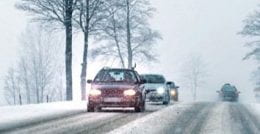Safe drivers know the weather and their limits. Follow these safe driving tips when hazardous weather is in the forecast.
Find out about driving conditions before you go. Be aware of the latest weather conditions by visiting kandrive.org. Call 5-1-1 from anywhere in Kansas or 1-866-511-KDOT (5368) from anywhere in the US. You can also visit 511 Mobile, http://511mm.ksdot.org, using your mobile device.
Make sure you can see and be seen. Turn signals, brake lights and windows need to be clear of snow. Check your vehicle’s tires, wiper blades, fluids, lights, belts, and hoses. A breakdown is bad on a good day and dangerous on a bad weather day.
Leave plenty of time to reach your destination safely. It’s not worth putting yourself and others in a dangerous situation just to be on time.
Buckle up. Secure children (and adults) in appropriate seat belts, boosters and car seats. Don’t strap into your car while wearing bulky winter clothing as it can affect the ability for seat belts and car seats to do their job.
Slow down for wet, snowy and icy conditions. Avoid quick braking or acceleration. Slow down and watch for black ice when approaching intersections, off-ramps, bridges, or shady spots. You should never use cruise control in winter weather conditions.
Stay attentive to your driving and avoid distractions. Don’t talk on your cell phone or use your mobile device (calling, texting, emailing, etc.) while driving.
Allow additional room between your vehicle and others. Be patient. Watch for sudden stops or turns. Don’t take chances when pulling out in front of approaching vehicles. It takes longer to stop and accelerate in bad weather.
Overall, If the weather is bad, remember Ice and Snow…Take It Slow, or just don’t go.
Find more about safe winter driving here.
By: Ashley Svaty
 As the temperature starts to fall and the winter months are ahead, here are some things to consider before getting on the road.
As the temperature starts to fall and the winter months are ahead, here are some things to consider before getting on the road. There are five main materials that are used as chemical de-icers: calcium chloride, sodium chloride (table salt), potassium chloride, urea, and calcium magnesium acetate.
There are five main materials that are used as chemical de-icers: calcium chloride, sodium chloride (table salt), potassium chloride, urea, and calcium magnesium acetate. We have been lucky this year with beautiful fall days and above normal temperatures. However, the forecast for the next few weeks shows temperatures dropping and we could possibly be facing snow or ice.
We have been lucky this year with beautiful fall days and above normal temperatures. However, the forecast for the next few weeks shows temperatures dropping and we could possibly be facing snow or ice.
